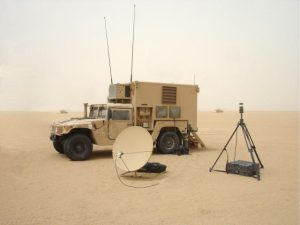
In its new configuration, the Profiler system (shown in Iraq) , now only needs one vehicle. Two support vehicles and a weather balloon have been removed from the previous version of the Profiler package. Photo Courtesy of PM Prophet
The ‘Snowball Effect’ is a term that military systems generally try to avoid in that they usually end up costing the government a great deal of money. When representatives from the Program Executive Office Intelligence Electronic Warfare & Sensors (PEO IEW&S) office took the stage May 12, at the Pentagon auditorium, they were instead recognized for a snowball that went right.
The organization was presented with a 2009 Value Engineering Achievement Award by the Honorable Zachary Lemnios, director of defense research and engineering, for their efforts dealing with the AN/TMQ-52A/B, Meteorological Measuring Set-Profiler (MMS-P). What started out as a look at the overall benefits the weather balloon sensor provides for the Profiler mission, turned into a major reduction in assigned Soldiers, vehicles and supporting materials that have already accounted for a significant Operation and Support (O&S) cost avoidance for the Army.
Value Engineering (VE) is a functional analysis process to identify actions that reduce cost, increase quality, and improve mission capabilities across the entire DoD enterprise. During the fiscal year 2009, 3,347 in-house VE proposals and 43 contractor-initiated VE change proposals were accepted with actual and projected savings/cost avoidance in excess of $1.94 billion.
The Profiler system provides the field artillery with modernized and enhanced data collection and automated analysis of current weather conditions, and prediction of conditions expected to occur in the near future along the trajectory and at a point or area where the weapon munitions are expected to engage a target. The system
began fielding in 2008 replacing the AN/TMQ-41 Meteorological Measuring Set (MMS) weather system, which relies completely on data collected from balloon sensors while the Profiler relies for the most part on Navy Operational Global Atmospheric Prediction System (NOGAPS) data fed to the system by the Air Force Weather Agency via satellite. As Profilers continue to be fielded, the last MMS will be replaced by the end of this year.
“Profiler models the atmosphere that the artillery round will pass through and tailors a meteorological (MET) message to the trajectory. That MET message is digitally transmitted to a firing unit and is ingested into the firing solution making corrections to the path of the round,” explained Gordon Wehri, deputy director, U.S. Army Training and Doctrine Command Project Office –Sensors. “This improvement/correction to the trajectory allows the artillery to engage the target with fewer rounds and with greater accuracy which equates to greater lethality.”
Extensive testing and modeling were performed to determine if removing the balloon sensors from the Profiler system would negatively affect the vital information that is used by artillery batteries when developing a firing solution. Building upon earlier studies the Army Research Laboratory at White Sands, NM; conducted an austere data study of the system at three separate locations for two months during 2006.
“We selected Kabul, Cape Town, and Hawaii because there are not many radars (present),” said Dr. Patrick Haines, ARL research meteorologist. The results showed a lack of impact on the mission when the balloon was removed. “Following the study the question was ‘why do we need that local balloon if we can do this well without it?”
“By removing the balloon capability in Profiler it allowed us to get rid of two out of the three vehicles, one of the trailers and most importantly, allow the Army to reassign four out of the six-person crew,” said Mike Karpie, acting product director Target Identification and Meteorological Sensors (PD TIMS). “The cost savings weren’t attributed to what we would save in production but mostly came from O&S cost avoidance associated with a two-thirds reduction in crew size.”
As the beneficial effects of the removal of balloon operations continue, the Profiler capability continues to evolve with the initiation of work on a Block III version. The Profiler Block III is expected to completely remove the need for vehicles and dedicated manning altogether. As it is envisioned, the Profiler Block III will basically be a software application hosted on a laptop computer directly connected to the Tactical Operations Center (TOC) Local Area Network (LAN) with the ability to autonomously provide meteorological data messages to Advanced Field Artillery Tactical Data System (AFATDS) upon request.
“[With Block III Profiler] when AFATDS has a fire mission and they need to come up with a fire solution, they will send a MET data request message over the TOC LAN addressed to the Profiler laptop. Based on the request, the Profiler will autonomously generate and send the required MET data back to the requesting AFATDS terminal,” explained Karpie. The Block III version of Profiler will be the next iteration in the evolution of meteorological systems for the Field Artillery community. The reduced logistics footprint of the Block III configuration, along with the elimination of dedicated system manpower requirements, will further increase the already significant O&S cost avoidance achievements of the program. Fielding is expected to begin in two to three years.